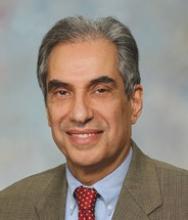PHOENIX – The majority of benign thyroid nodules treated with laser ablation shrunk by more than half and the procedures had a low complication rate, according to a 2-year randomized trial in four centers in Italy.
The 200-patient study showed that the procedure was fairly well tolerated without general anesthesia, and cost about $400 in disposables per procedures, Dr. Enrico Papini said at the annual meeting of the American Association of Clinical Endocrinologists.
Previous published studies by Dr. Papini (Thyroid 2007;17:229-35) and other European groups (Thyroid 2006;16:763-8) have shown good outcomes for laser ablation of cold thyroid nodules. However, minimally invasive procedures for treating benign or malignant thyroid nodules, including percutaneous ethanol injection (PEI), radiofrequency ablation (RFA), and laser ablation (LA), have not been widely adopted by U.S. specialists, said Dr. Hossein Gharib, president-elect of the American Thyroid Association and past-president of AACE. And experience matters.
"PEI should be first-line therapy for symptomatic, benign cysts," said Dr. Gharib, who was not involved in the study. "It is easy to do, safe and very effective. LA and RFA are more complicated and should be performed only by personnel with experience and equipment."
Dr. Papini said that the procedure is performed by interventional radiologists or endocrinologists "who are fairly experienced in percutaneous injections, or at least in the use of fine-needle aspiration biopsy." He added that it takes about a month of training to be effective in the procedure.
Dr. Papini and colleagues compared the clinical and ultrasound changes in benign thyroid nodules by ultrasound-guided LA with those who were follow-up only. They also assessed side effects and the efficacy of the technique in different centers.
Two hundred consecutive patients with a solid thyroid nodule with a volume of more than 5 mL and less than 18 mL were referred to four thyroid centers and randomly assigned to a single LA treatment (101 patients) or follow-up (100 patients).
In the treatment group, clinicians performed LA with a 1.064-nm neodymium yttrium-aluminum garnet laser with 2 fibers, and an output power of 3 watts. Energy delivery was 3,600 Joules for nodules up to 13 mL, and 7,200 J for nodules larger than 13 mL. The treatment was outpatient, took less than 30 minutes, and was fairly well tolerated, said Dr. Papini. Volume and local symptoms changes were evaluated 1, 6, 12, and 24 months after LA.
There was no need for general anesthesia.
"You don’t need anesthesia," said Dr. Papini of Regina Apostolorum Hospital, Rome. "It’s very important that the patient can tell you if he feels pain. Because you have pain only if the high temperature approaches the thyroid capsule, so you can stop one of the fibers that may be closer to the border of the nodule."
The control group received no treatment affecting the thyroid gland. Clinical, laboratory, and ultrasound control were performed at baseline and every 6 months thereafter for 3 years.
Results showed that a progressive nodule volume reduction was found at 6 months (–50.7%), 12 (–57.3%), and 24 (–60.9%) months (P < .001). A reduction of more than 50% was observed in 73.6% of the cases (P < .001).
Volume reduction in LA was progressive until 12 months and remained stable until 24 months. The 24-month mean volume reduction in the difference centers was 41.6%, 63.2%, 61.5%, and 58.7%.
Cost of disposables was about $400 for each procedure, and efficacy and side effects were similar in different centers, Dr. Papini reported.
The presence of pressure symptoms complaint decreased from 31% to 1% of the cases. There were four complications, including one case of self-resolving vocal cord paresis, one infection, and two fevers.
Meanwhile, the control group showed a 21.9% volume increase in 24 months, but local symptoms did not change significantly.
Although the procedure had several advantages, including no cosmetic damage and no risk of hypothyroidism, it’s not without drawbacks. Dr. Papini said that the nodules are persistent and need careful cytologic evaluation and follow-up. Also, the operator needs to be well trained, as complications can be severe during the learning period. There’s also a potential for regrowth, although none were reported during the trial’s 3-year follow-up.
"Currently, RFA is used in some centers for hepatic but not thyroid lesions," said Dr. Gharib, who practices at Mayo Clinic, Rochester, Minn. "It is likely that in the near future we will see the application of these techniques for thyroid masses."
Dr. Papini and Dr. Gharib had no relevant disclosures.
On Twitter @NaseemSMiller


